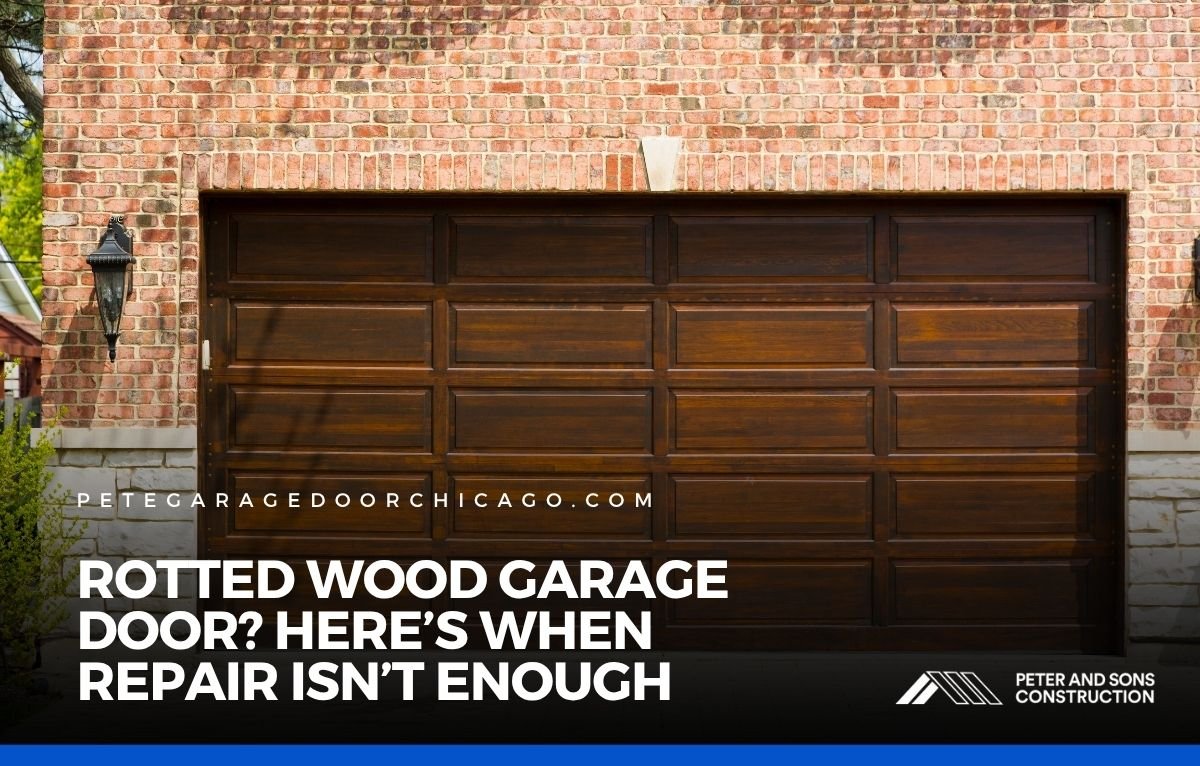A wood garage door brings warmth and curb appeal to any home, but it’s also vulnerable to moisture and decay.
When parts of the door begin to soften, peel, or crumble, what started as a small cosmetic issue can turn into structural damage.
A rotted wood garage door can affect safety, balance, and even energy efficiency. Knowing when a repair makes sense and when replacement is the smarter move can help you protect your home and your budget.
What Causes a Wood Garage Door to Rot
Rot begins when moisture seeps into exposed or unsealed wood. Once water finds its way beneath paint or finish, it creates an environment where fungus and mold can grow.
Over time, the wood fibers weaken, softening the surface and spreading the damage. This usually starts at the bottom of the door, near corners or panels that are closest to the ground.
Salt from driveways, rain runoff, or poor drainage can accelerate decay. Even small cracks in paint can let water in. When left alone, the damage spreads inward and eventually weakens hinges, panels, and the frame.
Signs You Might Still Be Able to Repair It
If you spot the problem early, your garage door might still be salvageable. The key is determining if the damage is limited to a small area or if it has already spread deeper. You can often repair a rotted wood garage door if the rest of the door is still strong and balanced.
You may still be able to repair the door if:
- The affected section is small, such as one bottom panel or edge.
- The door moves smoothly without sticking or uneven lifting.
- The rest of the wood feels solid when tapped or pressed.
For doors in this condition, a professional can remove the damaged area, treat the surface with wood hardener, fill gaps with epoxy, sand, and repaint. This approach restores the appearance and function without needing a complete replacement.
When Repair No Longer Makes Sense
If the rot has reached several panels, or the door feels heavy and unbalanced, repair might only delay the inevitable.
Replacing the door becomes more practical once the structure loses integrity. When decay affects key joints or panels, the door’s strength and stability are compromised.
A door that sags, creaks loudly, or feels uneven when opening is a strong sign of deeper rot. You may also notice that the automatic opener struggles more than usual.
Repainting over these problems won’t help; the damage inside the wood will keep spreading. In these situations, replacement is the safer and more cost-effective choice.
How a Proper Repair Should Be Done
A repair done the right way can extend the life of your door, but skipping steps usually means the problem will return.
The process starts with removing every trace of damaged wood until only solid material remains. A wood hardener is applied to strengthen the surrounding area and prevent new decay. After that, an exterior-grade filler or epoxy is used to rebuild the surface.
Once the area is smooth and fully cured, it should be sanded, primed, and painted with waterproof coatings. These finishing layers act as your first defense against moisture.
Many homeowners miss this step, but it’s crucial for long-term results. Without it, even a small rainstorm can restart the rot cycle.
Choosing the Right Replacement Material
If replacement is the best option, think about how to prevent the same problem from happening again.
While natural wood has a timeless look, other materials provide similar style with less upkeep. Composite doors, for example, mimic wood grain but don’t absorb water. Steel doors with wood-look finishes offer another durable alternative.
When choosing a new garage door, ask about insulation value, moisture resistance, and warranty coverage. These factors impact both performance and longevity. For homes in places where weather changes fast, durability and proper sealing matter just as much as appearance.
How to Prevent Future Rot
Once you’ve repaired or replaced your rotted wood garage door, routine care can keep it from returning. Moisture control and maintenance are the biggest factors.
Here’s how to keep your garage door protected:
- Keep gutters clear so rainwater doesn’t pool at the base of the door.
- Repaint or reseal exposed wood every couple of years.
- Check for gaps or cracks in weather stripping, especially before winter.
- Inspect the door at least twice a year for soft spots or peeling paint.
These habits take only a few minutes each season but can extend your door’s lifespan by years. A little maintenance now prevents the need for costly structural fixes later.
The Hidden Costs of Ignoring the Problem
Leaving a rotted wood garage door unchecked can lead to more than cosmetic issues. As the wood weakens, hinges loosen and panels shift, putting strain on the opener.
This misalignment can eventually cause motor failure or damage the tracks. A door that stops closing properly can also compromise your home’s security or let in drafts that raise energy bills.
In severe cases, parts of the door might even collapse, creating a safety hazard for anyone nearby. By taking action early, you avoid expensive repairs and keep your home both safe and visually appealing.
Ready to Protect Your Garage Door Investment
A rotted wood garage door might start as a small issue, but it can quickly grow into a problem that affects your home’s appearance, safety, and structure.
The best approach is to catch signs of damage early, address moisture issues, and know when to move from repair to replacement. When you work with a trusted professional, you’ll get honest advice and a solution that lasts.
Peter and Sons Constructions serves homeowners throughout Niles, IL, providing dependable garage door repairs, replacements, and maintenance services.
If your rotted wood garage door needs attention, our team can inspect it, explain your options, and recommend the right fix for your situation.

